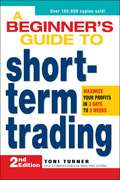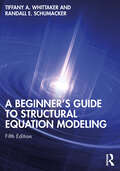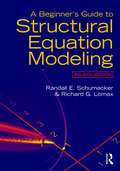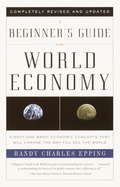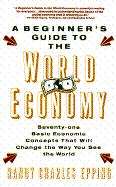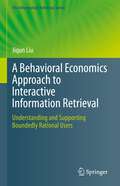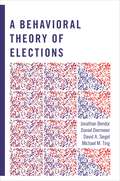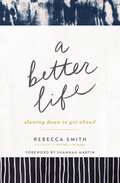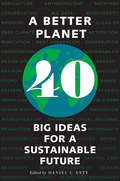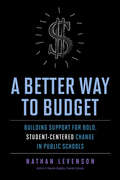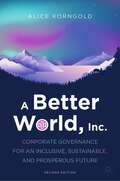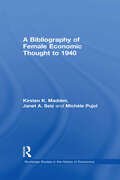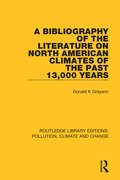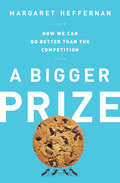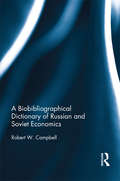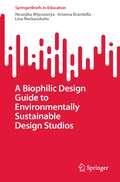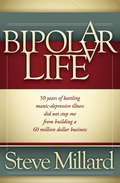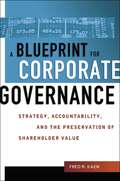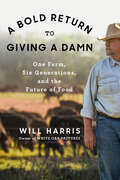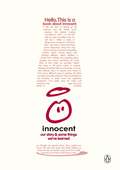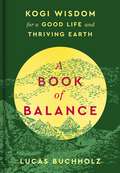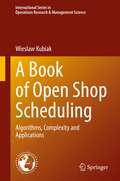- Table View
- List View
A Beginner's Guide to Short-Term Trading: Maximize Your Profits in 3 Days to 3 Weeks
by Toni TurnerTrade you way to financial success!Are you tired of playing the "buy-and-hope" game with your stocks? Savvy stock trader Toni Turner shows you the ins and outs and ups and downs of short-term trading. You'll learn how to buy and sell stocks on a monthly, weekly, or even daily basis, so you can own the right stocks at the right time. Turner's clear, common-sense advice, easy-to-follow explanations, and helpful examples will help you invest in the exciting and profitable world of short-term trading quickly and safely. In this revised edition, you'll get completely up-to-date information on: -New products such as ETFs and expanded coverage on sector investing -Resources for choosing an online broker New SEC (Securities and Exchange Commission) rules and regulations -Updated charts and graphs with current examples A Beginner's Guide to Short-Term Trading is the hands-on book designed to get you actively involved in every step of the trading process. Now you can take control of your portfolio and secure the financial freedom you've always dreamed of. Start planning your trades today!
A Beginner's Guide to Structural Equation Modeling
by Tiffany A. Whittaker Randall E. SchumackerA Beginner’s Guide to Structural Equation Modeling, fifth edition, has been redesigned with consideration of a true beginner in structural equation modeling (SEM) in mind. The book covers introductory through intermediate topics in SEM in more detail than in any previous edition. All of the chapters that introduce models in SEM have been expanded to include easy-to-follow, step-by-step guidelines that readers can use when conducting their own SEM analyses. These chapters also include examples of tables to include in results sections that readers may use as templates when writing up the findings from their SEM analyses. The models that are illustrated in the text will allow SEM beginners to conduct, interpret, and write up analyses for observed variable path models to full structural models, up to testing higher order models as well as multiple group modeling techniques. Updated information about methodological research in relevant areas will help students and researchers be more informed readers of SEM research. The checklist of SEM considerations when conducting and reporting SEM analyses is a collective set of requirements that will help improve the rigor of SEM analyses. This book is intended for true beginners in SEM and is designed for introductory graduate courses in SEM taught in psychology, education, business, and the social and healthcare sciences. This book also appeals to researchers and faculty in various disciplines. Prerequisites include correlation and regression methods.
A Beginner's Guide to Structural Equation Modeling: Fourth Edition
by Richard G. Lomax Randall E. SchumackerNoted for its crystal clear explanations, this book is considered the most comprehensive introductory text to structural equation modeling (SEM). Noted for its thorough review of basic concepts and a wide variety of models, this book better prepares readers to apply SEM to a variety of research questions. Programming details and the use of algebra are kept to a minimum to help readers easily grasp the concepts so they can conduct their own analysis and critique related research. Featuring a greater emphasis on statistical power and model validation than other texts, each chapter features key concepts, examples from various disciplines, tables and figures, a summary, and exercises. Highlights of the extensively revised 4th edition include: -Uses different SEM software (not just Lisrel) including Amos, EQS, LISREL, Mplus, and R to demonstrate applications. -Detailed introduction to the statistical methods related to SEM including correlation, regression, and factor analysis to maximize understanding (Chs. 1 - 6). -The 5 step approach to modeling data (specification, identification, estimation, testing, and modification) is now covered in more detail and prior to the modeling chapters to provide a more coherent view of how to create models and interpret results (ch. 7). -More discussion of hypothesis testing, power, sampling, effect sizes, and model fit, critical topics for beginning modelers (ch. 7). - Each model chapter now focuses on one technique to enhance understanding by providing more description, assumptions, and interpretation of results, and an exercise related to analysis and output (Chs. 8 -15). -The use of SPSS AMOS diagrams to describe the theoretical models. -The key features of each of the software packages (Ch. 1). -Guidelines for reporting SEM research (Ch. 16). -www.routledge.com/9781138811935 which provides access to data sets that can be used with any program, links to other SEM examples, related readings, and journal articles, and more. Reorganized, the new edition begins with a more detailed introduction to SEM including the various software packages available, followed by chapters on data entry and editing, and correlation which is critical to understanding how missing data, non-normality, measurement, and restriction of range in scores affects SEM analysis. Multiple regression, path, and factor models are then reviewed and exploratory and confirmatory factor analysis is introduced. These chapters demonstrate how observed variables share variance in defining a latent variables and introduce how measurement error can be removed from observed variables. Chapter 7 details the 5 SEM modeling steps including model specification, identification, estimation, testing, and modification along with a discussion of hypothesis testing and the related issues of power, and sample and effect sizes.Chapters 8 to 15 provide comprehensive introductions to different SEM models including Multiple Group, Second-Order CFA, Dynamic Factor, Multiple-Indicator Multiple-Cause, Mixed Variable and Mixture, Multi-Level, Latent Growth, and SEM Interaction Models. Each of the 5 SEM modeling steps is explained for each model along with an application. Chapter exercises provide practice with and enhance understanding of the analysis of each model. The book concludes with a review of SEM guidelines for reporting research. Designed for introductory graduate courses in structural equation modeling, factor analysis, advanced, multivariate, or applied statistics, quantitative techniques, or statistics II taught in psychology, education, business, and the social and healthcare sciences, this practical book also appeals to researchers in these disciplines. Prerequisites include an introduction to intermediate statistics that covers correlation and regression principles.
A Beginner's Guide to the World Economy
by Randy Charles EppingThe third edition updates the information in previous editions and explains many new concepts. What is the new economy? What is globalization? Is the euro the final seal on European Union? How is e-commerce transforming our world beyond economics? What is virtual money, and does it have real value? How do social concerns and societal ills (drugs, poverty, AIDS, endangered natural resources) play a part in the rapidly changing world economy. What are multinationals, and do they signal the end of nationalism? These and many other pertinent issues are concisely addressed in the most accessible primer for those who want to be economically literate (and who doesn't?).
A Beginner's Guide to the World Economy: 71 Basic Economic Concepts that will Change the Way You See the World
by Randy Charles EppingFrom arbitrage to the IMF, from exchange rates to money laundering, a clear exposition of how the global economy works. Includes a glossary of terms.
A Behavioral Economics Approach to Interactive Information Retrieval: Understanding and Supporting Boundedly Rational Users (The Information Retrieval Series #48)
by Jiqun LiuThis book brings together the insights from three different areas, Information Seeking and Retrieval, Cognitive Psychology, and Behavioral Economics, and shows how this new interdisciplinary approach can advance our knowledge about users interacting with diverse search systems, especially their seemingly irrational decisions and anomalies that could not be predicted by most normative models.The first part “Foundation” of this book introduces the general notions and fundamentals of this new approach, as well as the main concepts, terminology and theories. The second part “Beyond Rational Agents” describes the systematic biases and cognitive limits confirmed by behavioral experiments of varying types and explains in detail how they contradict the assumptions and predictions of formal models in information retrieval (IR). The third part “Toward A Behavioral Economics Approach” first synthesizes the findings from existing preliminary research on bounded rationality and behavioral economics modeling in information seeking, retrieval, and recommender system communities. Then, it discusses the implications, open questions and methodological challenges of applying the behavioral economics framework to different sub-areas of IR research and practices, such as modeling users and search sessions, developing unbiased learning to rank and adaptive recommendations algorithms, implementing bias-aware intelligent task support, as well as extending the conceptualization and evaluation on IR fairness, accountability, transparency and ethics (FATE) with the knowledge regarding both human biases and algorithmic biases.This book introduces a behavioral economics framework to IR scientists seeking a new perspective on both fundamental and new emerging problems of IR as well as the development and evaluation of bias-aware intelligent information systems. It is especially intended for researchers working on IR and human-information interaction who want to learn about the potential offered by behavioral economics in their own research areas.
A Behavioral Theory of Elections
by Jonathan Bendor Michael M. Ting Daniel Diermeier David A. SiegelMost theories of elections assume that voters and political actors are fully rational. While these formulations produce many insights, they also generate anomalies--most famously, about turnout. The rise of behavioral economics has posed new challenges to the premise of rationality. This groundbreaking book provides a behavioral theory of elections based on the notion that all actors--politicians as well as voters--are only boundedly rational. The theory posits learning via trial and error: actions that surpass an actor's aspiration level are more likely to be used in the future, while those that fall short are less likely to be tried later. Based on this idea of adaptation, the authors construct formal models of party competition, turnout, and voters' choices of candidates. These models predict substantial turnout levels, voters sorting into parties, and winning parties adopting centrist platforms. In multiparty elections, voters are able to coordinate vote choices on majority-preferred candidates, while all candidates garner significant vote shares. Overall, the behavioral theory and its models produce macroimplications consistent with the data on elections, and they use plausible microassumptions about the cognitive capacities of politicians and voters. A computational model accompanies the book and can be used as a tool for further research.
A Better Choice: Healthcare Solutions for America
by John C. GoodmanThe Patient Protection and Affordable Care Act—a.k.a. Obamacare—remains highly controversial and faces ongoing legal and political challenges. Polls show that by a large margin Americans remain opposed to the healthcare law and seek to &“repeal and replace&” it. However, the question is: Replace it with what?In A Better Choice, John C. Goodman clearly and concisely provides the compelling answer—no small feat, considering the complexity and intransigence of problems that have long plagued American healthcare. His prescription of four key reforms may garner the greatest attention as policymakers and the public search for a way out of the healthcare quagmire. For anyone who wants to learn about some of the boldest prescriptions designed to remedy our healthcare system, Goodman&’s book is a must-read.
A Better Life: Slowing Down to Get Ahead
by Rebecca SmithThe founder of Better Life Bags, Rebecca Smith, teaches us how to take little steps, say yes when God calls, and follow the passion He has given us.Let love stretch you. As the founder of one of the most popular custom handbag companies in the country, Rebecca Smith knows a thing or two about business. A highly successful entrepreneur in a world where the focus is on scalability, brand strategy, and global marketing, Rebecca Smith also knows the truth: that every success she's experienced at Better Life Bags has been the result of very small, very ordinary, very obedient steps of faith.Moving from Savannah, Georgia, to Hamtramck, Michigan, was culture shock enough for Rebecca. But trying to feel at home in a city where twenty-six different languages were spoken and most of the inhabitants were immigrants seemed downright impossible. It was only when Rebecca recognized that God had called her to this specific neighborhood at this particular moment in time that his plans began to unfold for her. Stepping forward into the place God had called her - a place that seemed messy and uncomfortable and unfamiliar - Rebecca discovered the true secret to success: when we slow down, pay attention, and trust that still, small voice of God to guide us, we just might change the world.Though Rebecca never set out to build a brand or create an empire, God saw Rebecca's heart for others, and began to multiply her efforts in ways she could have never imagined, creating a company where women from different cultures, faiths, and backgrounds work together for the good of others - for a better life.As you read this inspiring story, you will discover how to hear and follow God's voice for yourself as you slow down, take one small step at a time, and make a difference in the world right where you are.
A Better Planet: Forty Big Ideas for a Sustainable Future
by Daniel C. Esty Ingrid C. BurkeA practical, bipartisan call to action from the world’s leading thinkers on the environment and sustainability Sustainability has emerged as a global priority over the past several years. The 2015 Paris Agreement on climate change and the adoption of the seventeen Sustainable Development Goals through the United Nations have highlighted the need to address critical challenges such as the buildup of greenhouse gases in the atmosphere, water shortages, and air pollution. But in the United States, partisan divides, regional disputes, and deep disagreements over core principles have made it nearly impossible to chart a course toward a sustainable future. This timely new book, edited by celebrated scholar Daniel C. Esty, offers fresh thinking and forward-looking solutions from environmental thought leaders across the political spectrum. The book’s forty essays cover such subjects as ecology, environmental justice, Big Data, public health, and climate change, all with an emphasis on sustainability. The book focuses on moving toward sustainability through actionable, bipartisan approaches based on rigorous analytical research.
A Better Way to Budget: Building Support for Bold, Student-Centered Change in Public Schools
by Nathan LevensonA Better Way to Budget provides practical, innovative advice on how to overcome the political and social pushback that often prevents district and school leaders from shifting scarce resources to the most student-centered uses. Nathan Levenson shows how school leaders can uncover the sources of potential conflicts and create a budgeting process that normalizes change, minimizes pushback, and builds public buy-in for needed reforms.A Better Way to Budget:focuses on a strategic and process-oriented approach that anticipates roadblocks and challenges;introduces eight effective strategies for shifting funds and winning support;provides real-life examples of mistakes and successes; andincludes joint fact-finding, simulations, and other exercises to help stakeholders agree on goals and identify the budgetary changes needed to reach those objectives.Filled with advice gathered over decades of work in schools, A Better Way to Budget provides timely insights and tools for leaders who are exploring ways to make their districts more inclusive and student-centered.
A Better World, Inc.: Corporate Governance for an Inclusive, Sustainable, and Prosperous Future
by Alice KorngoldThe first edition of A Better World, Inc. showed how companies can profit by solving global problems. Increasingly, companies and investors are capitalizing on these opportunities. The three factors necessary for success were revealed to be effective corporate governance, stakeholder engagement, and collaboration. Racial equity and justice, and gender equity, were also themes in the original edition. By drawing on new research and case studies, this updated edition shows that inclusion and sustainability are in fact fundamental prerequisites for prosperity for companies and society. Specifically, racial inequity and injustice, and gender inequity, are systemic problems that impede businesses from achieving their greater potential in the global marketplace; in the meantime, society suffers as well. The second edition of A Better World, Inc. builds on the first by showing that companies have the power and incentives – and their boards of directors have the responsibility and the authority – to drive solutions to social, economic, and environmental challenges. Readers will learn how companies and their boards, together with nonprofits and governments, can drive prosperity by centering equity and sustainability.This edition is organized to address environmental, social, and governance practices, which are priority interests for investors, media, the public, government, and others to assess company practices and profitability.
A Beveridge Reader (The Works of William H. Beveridge)
by John Williams Karel WilliamsThe editors have chosen substantial extracts to illustrate the major themes and ideas in Beveridge’s writing over a period of more than four decades, ranging from his book Unemployment, published in 1909, to the Beveridge Report of 1942 and beyond. Sections cover his social philosophy; the crucial role he attributed to social insurance as a technique of welfare; his relation to economics; and the stress he placed on voluntary action in a free society. Each theme is introduced by a full editorial commentary which explains its place in Beveridge’s thought, as well as outlining his position and offering critical guidance to the reader. The return of mass unemployment and continuing debate on the role of the welfare state has revived interest in Beveridge’s work and this reader brings his ideas.
A Bibliography of Female Economic Thought up to 1940 (Routledge Studies in the History of Economics)
by Kirsten Madden Michele Pujol Janet SeizContributions to female economic thought have come from prolific scholars, leading social reformers, economic journalists and government officials along with many other women who contributed only one or two works to the field. It is perhaps for this reason that a comprehensive bibliographic collection has failed to appear, until now. This innovative book brings together the most comprehensive collection to date of references to women’s economic writing from the 1770s to 1940. It includes thousands of contributions from more than 1,700 women from the UK, the US and many other countries. This bibliography is an important reference work for systematic inquiry into questions of gender and the history of economic thought. This volume is a valuable resource and will interest researchers on women's contributions to economic thought, the sociology of economics, and the lives of female social scientists and activist-authors. With a comprehensive editorial introduction, it fills a long-standing gap and will be greeted warmly by scholars of the history of economic thought and those involved in feminist economics.
A Bibliography of the Literature on North American Climates of the Past 13,000 Years
by Donald K GraysonOriginally published in 1975, this extensive bibliography has been drawn from archaeological, botanical, geological, meteorological and zoological sources. It covers those studies which deal with periods of time for which modern observational data are not available. Included sources range from those which make minor contributions to our understanding of North American paleoclimates to those whose impacts upon this understanding have been considerable.
A Bigger Prize
by Margaret HeffernanA visionary business writer shows how to acheive success in all areas of life--by not competing for it. Tiger mothers stand by with tutors to make sure schoolchildren keep pace. At college, deepening debt is the only way to stay ahead. In the world of work, bond traders and derivatives sellers push ever-riskier products onto unsuspecting customers, themselves eager to pay for a lifestyle that demonstrates how well they're doing. How did we get sucked into a worldview that has proved so destructive, anti-social and wasteful? Whatever made us believe that competition would reward the smartest people, the greatest products, the best companies? Why do we trust that competitive games, markets and tests will magically identify the just winner? Surrounded by over-complex technology and cheap and tawdry merchandise, how could we imagine that competition is anything other than a forcef or devastation and waste? In her brilliant new book, Margaret Heffernan reveals how blind pursuit of success in business and life limits our opportunities and keeps us from positive choices. She argues that instead of allowing ourselves to be slaves to competition, we should tap into natural reserves of altruism, collaboration and cooperation. Those talents are innate and genetically hardwired, ripe for development, primed for innovation. Drawing on the latest scientific and economic research and her own numerous interviews with everyone from captains of industry to neuroscientists to Olympic athletes, Margaret Heffernan debunks competition as the ultimate answer to our biggest questions. But in doing so she reveals its positive aspects that until now have gone largely unacknowledged. This superbly readable book shows us how to do competition differently--and better--in business and in life.
A Bigger Prize: How We Can Do Better than the Competition
by Margaret HeffernanGet into the best schools. Land your next big promotion. Dress for success. Run faster. Play tougher. Work harder. Keep score. And whatever you do?make sure you win. Competition runs through every aspect of our lives today. From the cubicle to the race track, in business and love, religion and science, what matters now is to be the biggest, fastest, meanest, toughest, richest. The upshot of all these contests? As Margaret Heffernan shows in this eye-opening book, competition regularly backfires, producing an explosion of cheating, corruption, inequality, and risk. The demolition derby of modern life has damaged our ability to work together. But it doesnOCOt have to be this way. CEOs, scientists, engineers, investors, and inventors around the world are pioneering better ways to create great products, build enduring businesses, and grow relationships. Their secret? Generosity. Trust. Time. Theater. From the cranberry bogs of Massachusetts to the classrooms of Singapore and Finland, from tiny start-ups to global engineering firms and beloved American organizations?like Ocean Spray, Eileen Fisher, Gore, and Boston Scientific?Heffernan discovers ways of living and working that foster creativity, spark innovation, reinforce our social fabric, and feel so much better than winning. "
A Biographical Dictionary of Russian and Soviet Economists
by Robert CampbellDespite the restrictions on their work and actions, the economists of the Soviet period produced a great deal of bold and important work. With the erosion of the old Stalinist controls, economists in the Soviet Union themselves became very interested in the history of their profession, not least in order to find authentic voices that might offer reinforcement or counterpoint to the policy analyses and recommendations with which policy makers in the transition countries are today being bombarded. This major new reference work pulls together many years of research in order to present a bio-bibliographic dictionary of Russian and Soviet economists, many of whom have previously had no coherent record compiled of their careers, achievements and wider significance. Through exploring this rich tradition of economic thought, we can go some way in understanding the role of economists in the functioning of the Soviet system, as well as bringing previously forgotten work to light, raising new questions, and providing a memorial to those who suffered as a result of the system. This hugely detailed and important new volume takes into account all the nuances of the story of Russian and Soviet economic thought, such as regional issues, the reform and transition to a market economy, and the economic output of non-economists. Featuring nearly 500 entries, and including a detailed contextual introduction, this landmark volume will be a vitally important reference work for all those with an interest in the history of economic thought, the history of economics and Russian and Soviet history more generally.
A Biophilic Design Guide to Environmentally Sustainable Design Studios (SpringerBriefs in Education)
by Lina Markauskaite Arianna Brambilla Niranjika WijesooriyaThis book explores the current challenges of teaching biophilic design within environmentally sustainable design (ESD) education. It shows how design frameworks and success matrices can be used within ESD education, explores the development of biophilic design frameworks and shows how design thinking can be used to adopt biophilic design within ESD education. It introduces the new 'Process Bridging Technique (PBT)' that can be used to generate sustainable design frameworks able to fulfil the requirements of a performance-based approach and, at the same time, enhance human-nature connectedness. Based on an educational design research project developed in the past two years at the University of Sydney, this book informs new approaches to ESD education and bridges the spheres of research, education, and profession. It serves as a practical guide on how to systematically develop a design framework that can be used in architecture education, while presenting the pioneering 'Process Bridging Technique' developed by the authors.
A Bipolar Life: 50 Years of Battling Manic-Depressive Illness Did Not Stop Me From Building a 60 Million Dollar Business
by Steve MillardThe former Brookstone marketing guru gives &“proof of the fact that even in the face of this illness, a person can lead a rewarding and fulfilling life&” (Howard Lester, former Williams-Sonoma CEO). For more than forty-five years, Steve Millard has struggled with bipolar disorder. At his lowest, he was on the absolute brink of suicide, looking down into the abyss. Through his own methods of dealing with this disease, arrived at by trial and error, and the generous help of friends, and the teachings of a wonderful support group called Recovery Inc., he not only survived, he prospered, founding one of the most successful and profitable businesses in the direct marketing industry. A Bipolar Life is the story of his struggle. &“I have witnessed many of [Steve&’s] struggles with bipolar disorder and can only imagine how difficult they are for him. I have also witnessed his high, his incredible zest for life and the ability to live life to its fullest. But equally important, I have witnessed his marketing skills and how he helped pioneer the catalog and direct marketing industry. Those skills were a major part of the dynamic growth of the Brookstone Company.&” —Doug Anderson, former President, Brookstone &“Steve Millard was a good friend of L.L. Bean and a catalog marketing consultant instrumental to our success. He was upbeat and outgoing in his public life but quietly and courageously dealt with his emotional illness.&” —Leon Gorman, former CEO L.L. Bean
A Blueprint for Corporate Governance: Strategy, Accountability, and the Preservation of Shareholder Value
by Fred R. KaenTransparency has become a key objective of corporations and a pressing demand of shareholders, many of whom have seen their fortunes slip away because of financial irregularities and hyperinflated stock prices. And the best way to ensure that shareholders have a clear, accurate picture of a corporation's financial health is to ensure the soundness of its corporate governance--the complex policies and procedures that dictate the relationships between shareholders, boards of directors, CEOs, managers and employees, customers, suppliers, creditors, and more. Advocating a market-based corporate governance system based on maximizing shareholder wealth--but packed with safeguards to counter the effects of greed and incompetence--A Blueprint for Corporate Governance helps link each activity, whether it's pricing models, financial reporting, or dividend structure, to the crucial question: Does it increase shareholder wealth? Packed with real-world examples, academic research, and statistical data, A Blueprint for Corporate Governance is the first complete, authoritative guide to bring together a state-of-the-art overview of governance practices with a detailed plan for helping managers, executives, and boards of directors focus their activities on building value for the shareholder.
A Bold Return to Giving a Damn: One Farm, Six Generations, and the Future of Food
by Will Harris"If I could have one wish it is that every eater in America would read this book." —Ruth ReichlFrom a pioneer of the regenerative agriculture movement, a memoir-meets-manifesto on betting the farm on a better future for our food, animals, land, local communities, and our climateRaised as a fourth-generation farmer, when Will Harris inherited White Oak Pastures he was a full-time commodity cowboy who played hard and fast with every tool the system offered – chemicals, antibiotics, steroids, and more. His ancestors had built a highly profitable, conventionally-run machine, but over time he found himself disgusted with the excess, cruelty, and smalltown devastation this system entailed. So he bet the farm on forging a different way of doing things. One that works with nature not against it, and bridges the quickly widening delta between consumers and their food. Armed with tenacity, conviction and an outsized tolerance for risk, Harris called his approach &“radical traditional&” and it made him the pioneer of regenerative agriculture long before the phrase existed.At once an intimate, multi-generational memoir and a microcosm of American agriculture at large, A BOLD RETURN TO GIVING A DAMN offers a pathway back to producing food the right way. At a time when food supply chains are straining, climate-induced catastrophes are playing havoc with harvests, and concern around who owns America&’s farmland are more prescient than ever, Will Harris urges us to consider where the food we eat really comes from, and to re-connect to the places and people who raise what we eat each day. With keen storytelling, a good dose of irreverence, and an unflinching willingness to speak truth to power, Harris shows us why it&’s never been more important to know your farmer than now.Featured in Food and Country directed by Laura Gabbert and Ruth Reichl
A Book About Innocent: Our story and some things we've learned
by InnocentWe started making smoothies in 1999. On that first day we sold twenty-four bottles, and now we sell over 2 million a week, so we've grown since then. This book is about the stuff we've learned since selling those first few smoothies. About having ideas and making drinks, about running a business and getting started, about nature and fruit, about company life and working with friends, about the stuff we've got right and the stuff we got wrong, and about squirrels . . . and camping . . . and doing the right thing. We thought we'd write it all down in a book so we don't forget any of it, and to maybe help other people too. We started innocent from scratch, so we've learnt a lot of things by getting stuff wrong. Some other lessons have come from listening carefully to people clever than us. And some stuff we just got lucky on. But all of it, the good the bad and the useful, is in here. Plus, perhaps our mums will finally believe us when we tell them we haven't rung home for a while because we've been a bit busy these past few years.
A Book of Balance: Kogi Wisdom for a Good Life and Thriving Earth
by Lucas BuchholzWe all need help centering ourselves to serve ourselves and our world. In this small, beautiful book, the Kogi—a remote and ancient tribe in the mountains of Colombia--offer their learnings. They pose nine thought-provoking questions to help us live harmoniously with the earth and in turn find happiness and purpose in every moment.“Just as we are both sitting here and talking, this is how we can live well. All of this you will write in the book.”—Mama Jose Gabriel, a spiritual guide of the Kogi tribe, to author Lucas BuchholzFor centuries, the Kogi have lived in seclusion in Colombia’s remote Sierra Nevadas, known as “the heart of the world.” But in recent years, concerned by the environmental degradation they have experienced in their villages and forests, a few emissaries from the tribe emerged to bring an urgent and loving message to the West—advice on how to live in harmony with the earth.Buchholz was invited to their home to receive and transcribe this message. A Book of Balance takes us on a journey into a startlingly beautiful landscape and into a sacred space: the traditional fireside circle held regularly by the tribe. In this circle, members consider key questions essential to their community.In this slim volume of spiritual introspection, they ask us to share in their practice, posing nine questions that focus our minds and hearts on who we are, who we can become.Throughout we hear the words of the Kogi elders, wisdom that offers revelations, inspiration, and direction for our everyday lives.A beautiful book to own, to share with friends, and discuss in community.
A Book of Open Shop Scheduling: Algorithms, Complexity and Applications (International Series in Operations Research & Management Science #325)
by Wieslaw KubiakThis book provides an in-depth presentation of algorithms for and complexity of open shop scheduling. Open shops allow operations of a job to be executed in any order, contrary to flow and job shops where the order is pre-specified. The author brings the field up to date with more emphasis on new and recent results, and connections with graph edge coloring and mathematical programming. The book explores applications to production and operations management, wireless network scheduling, and timetabling. The book is addressed to researchers, graduate students, and practitioners in Operations Research, Operations Management, computer science and mathematics, who are developing and using mathematical approaches to applications in manufacturing, services and distributed wireless network scheduling.
